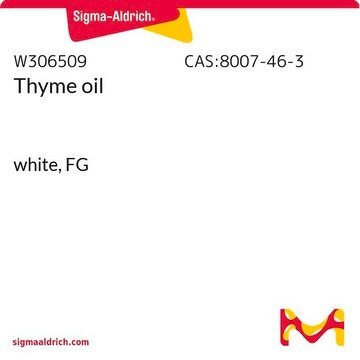W224511
Carvacrol
natural, 99%, FG
Synonim(y):
5-Isopropyl-2-methylphenol
About This Item
Polecane produkty
klasa czystości
FG
Fragrance grade
Halal
Kosher
natural
agency
follows IFRA guidelines
meets purity specifications of JECFA
zgodność regionalna
EU Regulation 1223/2009
EU Regulation 1334/2008 & 178/2002
FDA 21 CFR 117
Próba
99%
współczynnik refrakcji
n20/D 1.522 (lit.)
tw
236-237 °C (lit.)
mp
3-4 °C (lit.)
gęstość
0.976 g/mL at 20 °C (lit.)
Zastosowanie
flavors and fragrances
Dokumentacja
see Safety & Documentation for available documents
alergen pokarmowy
no known allergens
alergen zapachowy
carvacrol
Organoleptyczne
camphoraceous; woody; spicy
ciąg SMILES
CC(C)c1ccc(C)c(O)c1
InChI
1S/C10H14O/c1-7(2)9-5-4-8(3)10(11)6-9/h4-7,11H,1-3H3
Klucz InChI
RECUKUPTGUEGMW-UHFFFAOYSA-N
Szukasz podobnych produktów? Odwiedź Przewodnik dotyczący porównywania produktów
Opis ogólny
Zastosowanie
- Prophylactic efficacy of baicalin and carvacrol against Salmonella Typhimurium biofilm on food and food contact surfaces.: The study explores the effectiveness of carvacrol in preventing biofilm formation by Salmonella Typhimurium, with implications for food safety (Ashrafudoulla et al., 2024).
Hasło ostrzegawcze
Danger
Zwroty wskazujące rodzaj zagrożenia
Zwroty wskazujące środki ostrożności
Klasyfikacja zagrożeń
Acute Tox. 4 Oral - Aquatic Chronic 2 - Eye Dam. 1 - Skin Corr. 1B
Kod klasy składowania
8A - Combustible corrosive hazardous materials
Klasa zagrożenia wodnego (WGK)
WGK 3
Temperatura zapłonu (°F)
>212.0 °F
Temperatura zapłonu (°C)
> 100 °C
Certyfikaty analizy (CoA)
Poszukaj Certyfikaty analizy (CoA), wpisując numer partii/serii produktów. Numery serii i partii można znaleźć na etykiecie produktu po słowach „seria” lub „partia”.
Masz już ten produkt?
Dokumenty związane z niedawno zakupionymi produktami zostały zamieszczone w Bibliotece dokumentów.
Klienci oglądali również te produkty
Nasz zespół naukowców ma doświadczenie we wszystkich obszarach badań, w tym w naukach przyrodniczych, materiałoznawstwie, syntezie chemicznej, chromatografii, analityce i wielu innych dziedzinach.
Skontaktuj się z zespołem ds. pomocy technicznej








